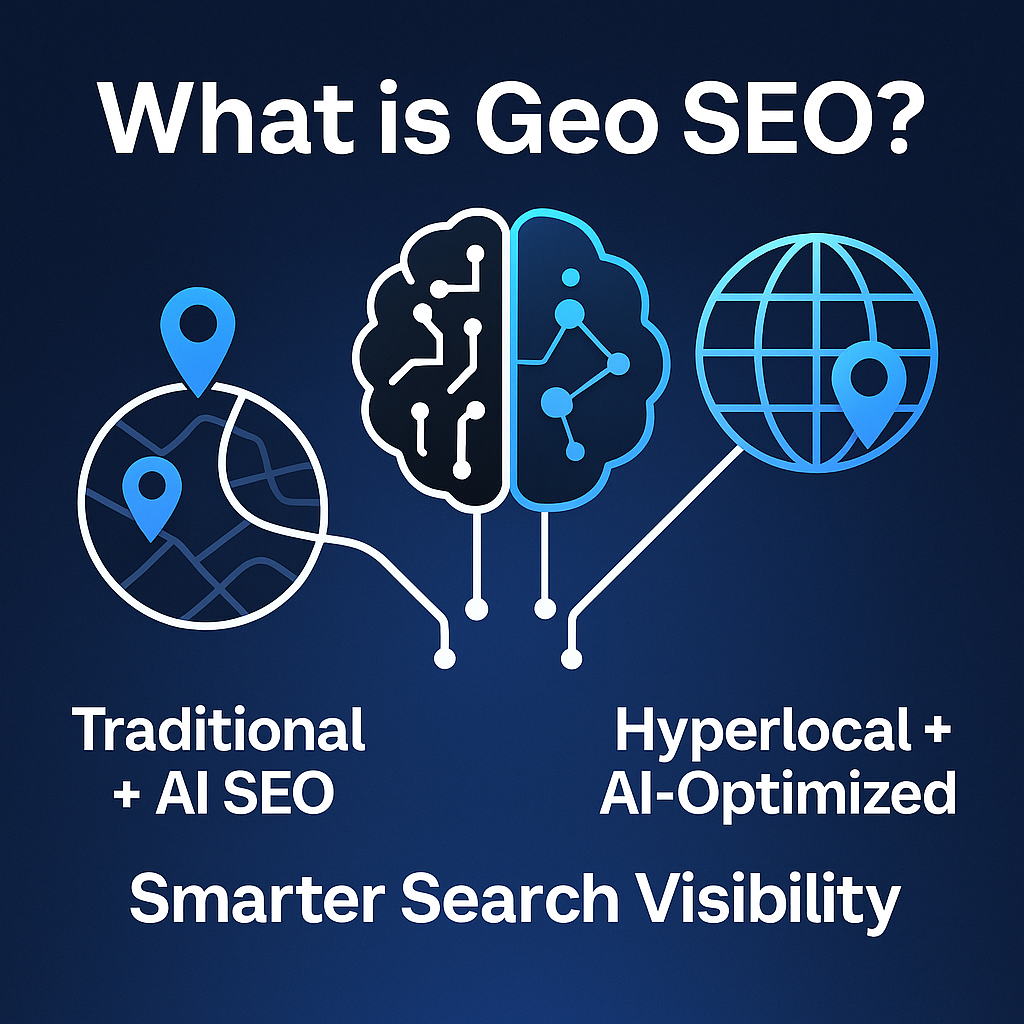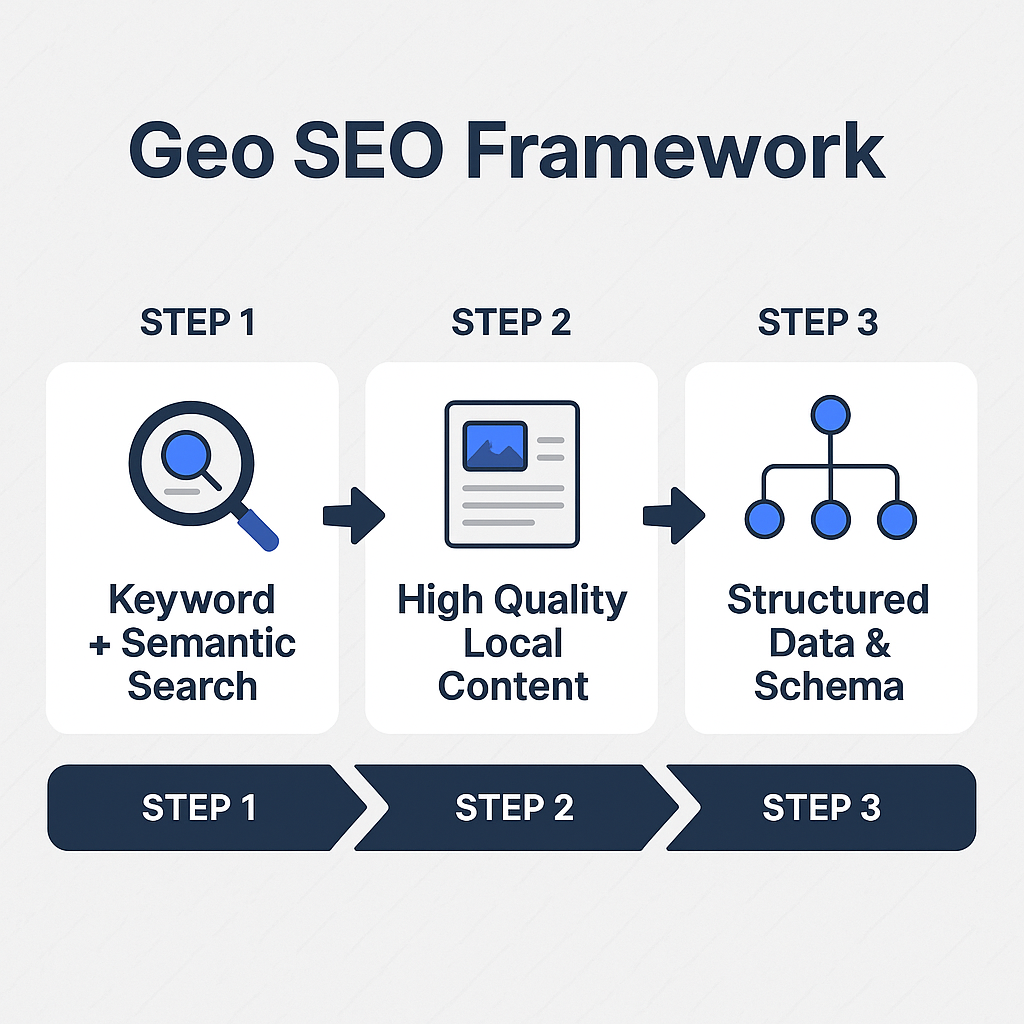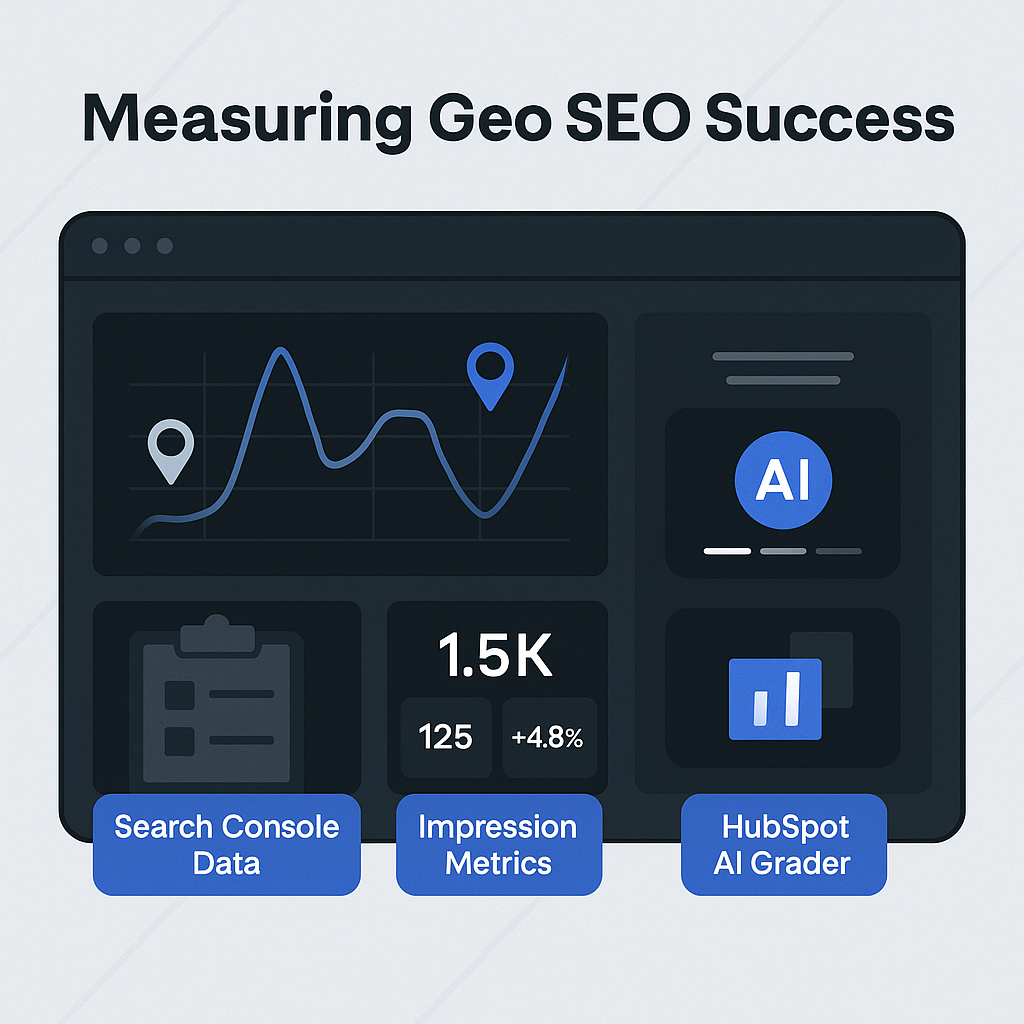
SEO Specialist
.jpg)
Geo SEO combines traditional SEO with AI-based techniques to boost online visibility. It keeps businesses competitive in traditional and AI-driven searches. In this article, we’ll explain Geo SEO, why it’s important and how to use it in your marketing strategy.

Geo SEO combines traditional SEO principles with generative engine optimization (GEO) to keep businesses visible across both traditional search and AI-driven search platforms.
With hyperlocal content marketing on the rise, businesses need to tailor their content to their local areas. These trends will impact how businesses execute their online marketing strategies and adapt to the changing digital landscape.
Geo SEO combines traditional SEO techniques with generative engine optimization (GEO) to improve online visibility. As AI tools evolve, GEO becomes important to stay visible and competitive. Unlike traditional SEO which focuses on keyword frequency, GEO ensures content meets AI algorithms standards for understanding and prioritizing information.
This dual approach allows businesses to boost their online presence by using both traditional SEO techniques and advanced AI-driven strategies. By integrating geo strategies, businesses can target their audience, improve search rankings and increase organic search traffic. This will not only give better search engine results but also ensure the content is relevant and engaging to users.
Geo SEO is for AI-driven search engines, traditional SEO is for standard search engines. This is important as it dictates the strategies businesses need to adopt to stay competitive. Geo SEO emphasizes clarity and structure in content which is important for AI engines to understand and prioritize information, traditional SEO often prioritizes keyword frequency.
While Geo SEO complements traditional SEO, it modifies common SEO tactics like targeted keywords and quality content to engage AI-driven search engines better. This dual approach ensures businesses can stay visible on both traditional and AI-driven platforms.Understanding and applying these differences will help businesses optimize their strategies, improve search rankings and online visibility and get a deeper understanding of market dynamics and brand visibility.
Incorporating Geo SEO strategies can boost a business’s overall digital marketing effectiveness. With AI-powered search engines changing the content landscape, brands need to rethink their content creation approach to capture and retain user attention on AI-driven platforms. Leveraging AI-powered marketing systems can help optimize content to increase visibility in AI-generated responses and expand audience reach.
To integrate Geo SEO into your strategy:
Measuring the success of your Geo SEO efforts is also important. Impression metrics will help you determine the visibility and relevance of your content to user queries and give you valuable insights into your Geo SEO strategy. Refine your approach based on these insights and keep your digital marketing strategy competitive.
Generative Engine Optimization (GEO) is key in modern search engine optimization, adapting content strategies to the demands of AI-driven search engines. Unlike traditional SEO which focuses on ranking in standard search engines, GEO prioritizes performance in AI-driven environments, particularly in generative engines.
This is driven by the growing influence of AI and machine learning which is changing how search engines understand and prioritize information. As a result optimizing content for generative ai research models is important to stay relevant and visible across AI platforms.
GEO can’t be overstated in today’s digital landscape. AI enhances user interaction by analyzing search queries and providing tailored results, making GEO more important due to hyper-personalized search experiences. With over 50% of organic search traffic expected to disappear as consumers adopt AI-powered search, businesses need to adapt.
Geo SEO combines traditional optimization techniques with strategies for AI-driven search platforms, improves search rankings and online visibility. Those who use geo strategy today will lead tomorrow’s digital world, stay ahead of the competition.Incorporating GEO into your SEO strategy has many benefits. One of the main benefits is improved search rankings as GEO aligns your content with the criteria used by AI algorithms to determine relevance. This alignment means your content is more likely to be prioritized and shown in AI-generated search results, capture a larger audience and increase your online presence.
Also GEO enhances user engagement by making content more relevant and appealing to users through geo focuses. By focusing on creating high quality, relevant content that meets user needs, businesses can increase user satisfaction and drive more organic traffic to their website.
Despite the benefits, implementing GEO has several challenges. One major challenge is the lack of established metrics to measure its effectiveness compared to traditional SEO. This makes it hard for businesses to measure the impact of their GEO efforts and refine their strategy accordingly.
To overcome this challenge, businesses can consider creating custom key performance indicators (KPIs) or adapt existing SEO metrics to benchmark their GEO efforts. By doing so they can get valuable insights into their Geo SEO strategy and make data driven decisions to increase online visibility and search rankings.

Geo SEO involves understanding the specific elements that increase visibility in AI-driven search environments. By using keyword and semantic research, creating high quality content and using structured data businesses can improve search rankings and increase online presence.
Also using real-time data analytics can help businesses target users better and refine their Geo SEO strategy.
Keyword research is critical for generative search engines as all searches start with a keyword. When choosing keywords for GEO, it’s important to balance search volume and competition, ensure relevance to the audience. Using keyword research tools can give insights into keyword volume, competition and trends which are important for strategic planning.
Understanding user demographics can further refine content strategy to better meet user intent, improve SEO. Focusing on relevant keywords and aligning them with user intent can improve search rankings and drive more organic traffic.
High quality content is important for AI-generated responses, making content quality a key factor in Geo SEO. A well-structured article improves time on page and reduces bounce rates, increase user engagement and search rankings. AI tools are evolving to help in creating high quality, search optimized content by analyzing existing successful content and identifying gaps to provide relevant answers.To create relevant and engaging content, businesses should focus on understanding user intent and providing comprehensive answers, authoritative information. This will not only improve search rankings but also increase user satisfaction and drive more organic traffic to their website to create content.
Using structured data is important to help AI to understand the context of your content which improves visibility. Schema markup helps to clarify the meaning of your content making it easier for AI models to categorize and retrieve relevant information. By using schema markup and structured data businesses can increase content relevance and search rankings in AI-driven search environments.
Including these technical SEO practices ensures your content is discoverable and accessible to both users and AI-driven search engines. This will not only increase your online visibility but also improve overall user experience and drive more traffic to your website.

Optimizing for AI-driven search engines requires a strategic approach that prioritizes user intent and contextual relevance. Unlike traditional SEO which often focuses on keyword-centric approach, Geo SEO focuses on understanding user intent and providing comprehensive, high quality content that meets user needs to optimize content.
By including multimedia, using schema markup and focusing on technical SEO practices businesses can increase content visibility and relevance in AI-driven search environments.
Understanding user’s intent is key as it refers to what users search for and why. AI-driven search engines focus on content that offers solutions to users’ problems. They go beyond just matching keywords. In Geo SEO selecting keywords that align with user intent and geographical relevance is important.
AI tools can speed up content creation and align output with AI-driven search models. Establishing authority is crucial for higher rankings in AI-driven search engines. Strategies that prove trustworthiness and reliability can increase content authority, provide valuable ai overviews.
Increasing engagement can be done by using bullet points and short paragraphs, making the content digestible for AI engines. Adding a personal tone, voice and experiences enriches the content, making it more relatable and engaging. AI technologies will refine search personalization, increase relevance of results based on user behavior and preferences.
Including different media types caters to diverse user preferences and improves retention. AI algorithms often favor interactive content, increase user engagement. Integrating multimedia such as images, videos and interactive elements creates a more engaging and dynamic user experience.This will not only increase user engagement but also increase your content’s visibility in AI-driven search engines. As users interact more with multimedia content, it tells AI algorithms that your user generated content is relevant and valuable, improve your search rankings and drive more organic traffic to your website. Also user feedback plays a big role in refining your strategies.
Technical SEO ensures a site is technically sound and accessible for AI algorithms. Traditional technical SEO is still important for site discoverability and accessibility, allowing search engines to crawl and index efficiently. Key elements that enhance a site’s crawlability for AI search engines are:
AI-driven engines require structured content to consume it. Page speed is a priority for AI-driven search engines as they deliver fast-loading websites and seamless user experience. Google’s algorithm penalizes slow-loading sites, making page speed optimization important for AI-powered engines.

Measuring success in Geo SEO is important to understand the impact of optimization strategies on online visibility. Key metrics to track Geo SEO performance are:
By monitoring these metrics businesses can refine their Geo SEO strategies and stay competitive in the ever changing digital landscape.
Monitoring GEO performance helps to see if the strategy increases rankings, traffic and conversions. Key tools and metrics are:
Monitoring content decay prevents decline in organic traffic and revenue. Content Rankings report shows which articles are losing rankings, so businesses can take corrective actions.
Authority indicators, such as social proof, citations and endorsements from industry experts, gauge credibility in Geo SEO.
AIOSEO’s Search Statistics module has a Content’s Performance report that shows key metrics like Clicks, Impressions and Position, so users can monitor content’s performance over time. Insights from Content’s Performance report will show how well the content optimization strategy is performing and guide future content adjustments.Tools like HubSpot’s AI Search Grader can help you measure content performance in AI search results, which is important to adapt to changing search technologies. Using both traditional analytics tools and AI-driven tools will help you track Geo SEO better, so your strategies stay relevant.
AI will shape the search landscape of Geo SEO more and more, resulting to more personalized and direct answers. Optimizing for voice and visual search is becoming important in Geo SEO as users prefer these methods for local queries, as shown in google ai overviews. Traditional search engines are also adapting to these changes.
By being ahead of the curve, you can ensure your SEO strategies stay effective.
GEO implementation is a continuous journey that requires ongoing adjustments. AI will continue to change SEO practices, so you need to adapt to remain competitive in AI-driven search environments.
AI will likely lead to new SEO methodologies that prioritize adaptability and responsiveness. You need to stay updated with the latest AI trends to ensure your SEO strategies are aligned with the emerging trends and technologies.
Voice search optimization is getting more important, with queries becoming more conversational and often including phrases like ‘near me’ or ‘open now’. Optimizing for voice queries requires natural language processing to understand user intent. By targeting conversational phrases and local queries, you can cater to on-the-go users and improve your search rankings.
Optimizing for voice search means understanding how users phrase their user’s query and their search behavior which has shifted to natural language. By focusing on these strategies, you can increase your online visibility and drive more organic traffic from mobile, voice and visual search results.
Geo SEO is the combination of traditional SEO and generative engine optimization, a holistic approach to maintaining online visibility in the ever changing digital landscape. By incorporating Geo SEO strategies, you can improve your search rankings, user engagement and stay competitive in AI-driven search environments. Key components of effective Geo SEO are keyword research, high quality content creation and technical SEO practices.As AI evolves, you need to stay updated with the latest trends and adjust your SEO strategies. By embracing Geo SEO and refining your approach, you can keep your online presence strong and relevant and drive more organic traffic and maximize your digital marketing efforts. Jump into Geo SEO and position your brand for 2025 and beyond.
Geo SEO increases online visibility by combining traditional search engine optimization with location-based strategies so your content ranks well on both traditional and AI-driven search engines. This is important for businesses that want to attract local customers.
Geo SEO focuses on local search relevance and structured content to increase visibility in specific geographic areas whereas traditional SEO is more on keyword optimization and general content strategies. This targeted approach makes Geo SEO more effective for businesses serving localized markets.
GEO is important for modern SEO because it allows businesses to deliver hyper-personalized search experiences, increase user interaction and engagement. Adapting to GEO strategies can boost visibility and customer connections.
Geo SEO has comprehensive keyword research, high quality content creation and proper use of structured data and schema markup. These components increase local search visibility and user engagement.
To measure the success of your Geo SEO, focus on key metrics such as search rankings, user engagement and interactive content performance. Use AIOSEO’s Search Statistics module and HubSpot’s AI Search Grader to track these metrics.Geo SEO: Mastering Generative Engine Optimization in 2025